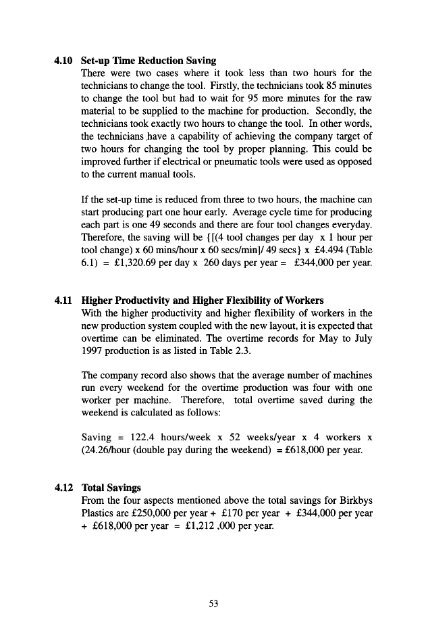(jit) principles and systematic layout planning as tools to improve ...
(jit) principles and systematic layout planning as tools to improve ...
(jit) principles and systematic layout planning as tools to improve ...
Create successful ePaper yourself
Turn your PDF publications into a flip-book with our unique Google optimized e-Paper software.
4.10 Set-up Time Reduction Saving<br />
There were two c<strong>as</strong>es where it <strong>to</strong>ok less than two hours for the<br />
technicians <strong>to</strong> change the <strong>to</strong>ol. Firstly, the technicians <strong>to</strong>ok 85 minutes<br />
<strong>to</strong> change the <strong>to</strong>ol but had <strong>to</strong> wait for 95 more minutes for the raw<br />
material <strong>to</strong> be supplied <strong>to</strong> the machine for production. Secondly, the<br />
technicians <strong>to</strong>ok exactly two hours <strong>to</strong> change the <strong>to</strong>ol. In other words,<br />
the technicians .have a capability of achieving the company target of<br />
two hours for changing the <strong>to</strong>ol by proper <strong>planning</strong>. This could be<br />
<strong>improve</strong>d further if electrical or pneumatic <strong><strong>to</strong>ols</strong> were used <strong>as</strong> opposed<br />
<strong>to</strong> the current manual <strong><strong>to</strong>ols</strong>.<br />
If the set-up time is reduced from three <strong>to</strong> two hours, the machine can<br />
start producing part one hour early. Average cycle time for producing<br />
each part is one 49 seconds <strong>and</strong> there are four <strong>to</strong>ol changes everyday.<br />
Therefore, the saving will be {[(4 <strong>to</strong>ol changes per day x 1 hour per<br />
<strong>to</strong>ol change) x 60 mins/hour x 60 secs/min]/ 49 sees} x £4.494 (Table<br />
6.1) = £1,320.69 per day x 260 days per year = £344,000 per year.<br />
4.11 Higher Productivity <strong>and</strong> Higher Flexibility of Workers<br />
With the higher productivity <strong>and</strong> higher flexibility of workers in the<br />
new production system coupled with the new <strong>layout</strong>, it is expected that<br />
overtime can be eliminated. The overtime records for May <strong>to</strong> July<br />
1997 production is <strong>as</strong> listed in Table 2.3.<br />
The company record also shows that the average number of machines<br />
run every weekend for the overtime production w<strong>as</strong> four with one<br />
worker per machine. Therefore, <strong>to</strong>tal overtime saved during the<br />
weekend is calculated <strong>as</strong> follows:<br />
Saving = 122.4 hours/week x 52 weeks/year x 4 workers x<br />
(24.26/hour (double pay during the weekend) = £618,000 per year.<br />
4.12 Total Savings<br />
From the four <strong>as</strong>pects mentioned above the <strong>to</strong>tal savings for Birkbys<br />
Pl<strong>as</strong>tics are £250,000 per year + £170 per year + £344,000 per year<br />
+ £618,000 per year = £1,212 ,000 per year.<br />
53


